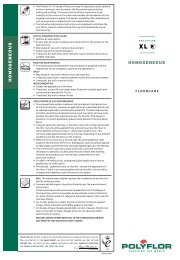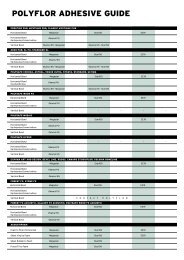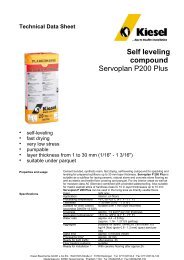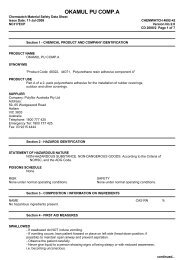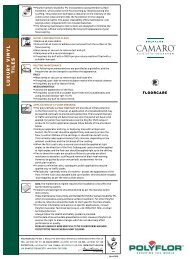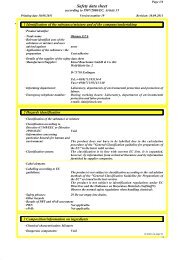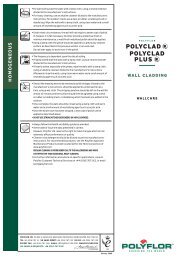Installation of Homogeneous vinyl sheet - Polyflor
Installation of Homogeneous vinyl sheet - Polyflor
Installation of Homogeneous vinyl sheet - Polyflor
Create successful ePaper yourself
Turn your PDF publications into a flip-book with our unique Google optimized e-Paper software.
POLYFLOR TECHNICAL INFORMATION<br />
<strong>Installation</strong> <strong>of</strong> <strong>Homogeneous</strong> <strong>vinyl</strong> <strong>sheet</strong><br />
On receipt <strong>of</strong> rolls, check that colours correspond<br />
to those ordered, that quantities are correct<br />
and that there is no damage. In particular,<br />
check that rolls are from one batch, if that was<br />
requested on the order. On arrival at site, the<br />
rolls should be safely secured in an upright<br />
position and stored, together with the adhesive,<br />
at a minimum temperature <strong>of</strong> 18ºC for at least<br />
24 hours before laying.<br />
Inflammable adhesives require special storage<br />
conditions. Contact the adhesive manufacturer<br />
or see current literature for details.<br />
To achieve best results, site conditions should<br />
be as described in BS 8203. A working<br />
temperature <strong>of</strong> between 18ºC and 26ºC is<br />
required for at least 24 hours prior to, and<br />
during, the laying period and for 24 hours<br />
afterwards. Conditioning areas and laying areas<br />
should be <strong>of</strong> similar temperature, to prevent<br />
thermally induced dimensional changes.<br />
In installations where underfloor heating is<br />
used, this should be switched <strong>of</strong>f from 48 hours<br />
prior to installation until 48 hours afterwards.<br />
It should then be slowly brought back up to the<br />
working temperature, a maximum <strong>of</strong> 27ºC.<br />
Adhesives capable <strong>of</strong> withstanding<br />
temperatures up to 27ºC should be used. Where<br />
direct sunlight, sometimes in conjunction with<br />
underfloor heating, creates high surface<br />
temperatures on the floor, an approved epoxy<br />
or polyurethane adhesive should be used.<br />
The work area should now be prepared to<br />
receive the <strong>vinyl</strong> <strong>sheet</strong> flooring. Ensure that all<br />
other trades have completed their work and<br />
removed all their equipment and materials.<br />
Remove all debris and sweep or vacuum the<br />
whole floor area. Check the condition <strong>of</strong> the<br />
subfloor and make good as necessary. Stone or<br />
power grind any cementicious subfloor to<br />
remove any “nibs” or ridges. Remove any<br />
surface contaminants, which may affect<br />
adhesion. Sweep or vacuum again prior to<br />
laying. If required by the contract, or if in<br />
doubt, check the moisture content <strong>of</strong> the subfloor<br />
and record the results and method used.<br />
Good lighting is essential.<br />
It is important to note that commencement <strong>of</strong><br />
work is deemed by many as acceptance <strong>of</strong> the<br />
site conditions as being suitable for laying<br />
floorcoverings.<br />
3.1 LAYOUT OF VINYL SHEET<br />
The architect may have provided a drawing<br />
showing the direction in which the material<br />
should be laid. In this case, lay the <strong>vinyl</strong> <strong>sheet</strong><br />
as directed. If the architect has left this to the<br />
discretion <strong>of</strong> the flooring contractor, it is<br />
advisable to show at the tender stage in which<br />
direction the material will be laid and state that<br />
your estimate is based on this. Always pay<br />
particular attention to where seams will fall,<br />
avoiding such occurrences as seams in the<br />
centre <strong>of</strong> doorways. If large windows are<br />
installed, minimise the effect <strong>of</strong> the joints by<br />
laying towards the window.<br />
3.2 SLABBING THE VINYL SHEET<br />
<strong>Polyflor</strong> recommends that all <strong>Polyflor</strong> <strong>vinyl</strong><br />
<strong>sheet</strong> flooring be rolled out face upward, taking<br />
care not to damage the surface, and cut<br />
approximately to size. Allowance <strong>of</strong> at least<br />
75mm should be made at the ends for trimming<br />
in, the slabs should then be left overnight<br />
for 24 hours, to condition at a minimum<br />
temperature <strong>of</strong> 18ºC.<br />
3.3 FITTING THE FIRST LENGTH<br />
3.3.1 Non-foam backed products<br />
Place the first <strong>sheet</strong> in position next to the wall<br />
with the outer edge approximately 15mm from<br />
the nearest point. Adjust the lie <strong>of</strong> the <strong>sheet</strong> so<br />
that the inner edge is parallel with the axis <strong>of</strong><br />
the room (Figure 1).<br />
Figure 1 Lining up the first <strong>sheet</strong><br />
WWW.POLYFLOR.COM<br />
Depending upon the depth <strong>of</strong> the recesses,<br />
either a bar scriber or a pair <strong>of</strong> scribers should<br />
be used to trace the pr<strong>of</strong>ile <strong>of</strong> the wall.<br />
The scribers should be set to allow for the<br />
deepest recess or rake <strong>of</strong> the wall. Holding the<br />
scribers vertically and square to the <strong>vinyl</strong> edge,<br />
trace the wall pr<strong>of</strong>ile onto the face <strong>of</strong> the <strong>sheet</strong><br />
(Figure 2). With this method, all irregularities<br />
<strong>of</strong> the wall will be accurately reproduced onto<br />
the surface <strong>of</strong> the <strong>vinyl</strong> <strong>sheet</strong>. If, because <strong>of</strong> the<br />
colour or decoration, the scribed line is difficult<br />
to see, rub suitably contrasting chalk dust into<br />
the line to highlight it.
POLYFLOR TECHNICAL INFORMATION<br />
Figure 2 Scribing the wall pr<strong>of</strong>ile<br />
Ease the <strong>sheet</strong> away from the wall and, using a<br />
hook blade trimming knife, cut <strong>of</strong>f the excess<br />
<strong>vinyl</strong> to the scribed line. Slide the <strong>sheet</strong> back<br />
against the wall and check the fit, making any<br />
minor adjustments as necessary.<br />
When satisfied that the fit on the first edge is<br />
correct, use a pencil to trace the opposite edge<br />
onto the subfloor (line A-B in Figure 3).<br />
In the centre <strong>of</strong> the room, draw a line on both<br />
the <strong>vinyl</strong> and subfloor square to the main axis<br />
<strong>of</strong> the <strong>sheet</strong> (line C-D in Figure 3).<br />
Figure 3 Marking the position<br />
Keeping the inner edge <strong>of</strong> the <strong>vinyl</strong> on line A-B,<br />
slide the <strong>sheet</strong> back to clear the wall at one end<br />
<strong>of</strong> the room.<br />
Set the scribers to the distance now between<br />
lines C and D (Figure 4). Trace the end wall<br />
pr<strong>of</strong>ile and cut to fit as described in preceding<br />
paragraphs.<br />
Figure 4 Setting the scriber<br />
Repeat for the other end <strong>of</strong> the <strong>sheet</strong>. Once<br />
completed, the whole <strong>sheet</strong> – when slid back<br />
into position – should fit the wall pr<strong>of</strong>iles exactly.<br />
Note: If fitting to set-in coving, the same<br />
principles apply but a reverse scriber must be<br />
used to trace the toe onto the <strong>sheet</strong>. It is<br />
normal to free hand cut to the coving, allowing<br />
12mm overlap for final trimming in.<br />
3.4 FITTING SUBSEQUENT LENGTHS<br />
Place the second length parallel to the first<br />
length, with a maximum 25mm overlap along<br />
the adjoining edges. On the opposite side, trace<br />
the edge along the whole length onto the<br />
subfloor. In the middle, draw a line C-D at right<br />
angles to the main axis, as previously<br />
described.<br />
Using the longitudinal line as a guide, slide back<br />
the <strong>sheet</strong> from the end wall and fit as described<br />
in Section 3.3.1. Repeat for the opposite end.<br />
Repeat the sequence for all remaining lengths.<br />
On the final length, which abuts the opposite<br />
wall, fit as described for the first length<br />
(Section 3.3.1).<br />
3.5 CUTTING IN THE SEAMS<br />
<strong>Polyflor</strong> recommends that all <strong>Polyflor</strong> <strong>vinyl</strong><br />
<strong>sheet</strong> floorcoverings are welded. Seam cutting,<br />
grooving and heat welding are described in<br />
detail in Section 11.<br />
Note: The seams should be cut before the<br />
adhesive is spread.<br />
3.6 ADHERING THE VINYL SHEET<br />
Prior to adhering the <strong>vinyl</strong> <strong>sheet</strong>, it is important<br />
to read and understand the adhesive<br />
manufacturer’s instructions, recommendations<br />
and safety advice. You need to know the<br />
hazards and limitations <strong>of</strong> the adhesive,<br />
especially the open time.<br />
Never spread more adhesive than can be laid<br />
within the open time. <strong>Polyflor</strong> does not<br />
recommend any method <strong>of</strong> adhesive<br />
application, such as rolling or spraying, which<br />
cannot guarantee the spread rate.<br />
3.6.1 Wet set adhesives<br />
Wherever practical, start with central strips<br />
first, as these are usually easier, having fewer<br />
recesses or awkward fittings.<br />
A. Fold back the <strong>sheet</strong> to just over half its length,<br />
making sure the remaining half retains its position.<br />
B. Spread the adhesive using a notched trowel <strong>of</strong><br />
the correct size, as recommended by the adhesive<br />
manufacturer. Maintain the correct size <strong>of</strong><br />
notch at all times, recutting as necessary as work<br />
progresses.<br />
C. When the adhesive is ready to accept the<br />
floorcovering, roll the <strong>vinyl</strong> <strong>sheet</strong> back into place,<br />
rubbing from the centre to the edge, taking care<br />
not to twist the roll or trap air bubbles.<br />
WWW.POLYFLOR.COM<br />
D. Check that seams are without gaps and<br />
remove any excess adhesive.<br />
E. Roll with a 68kg articulated floor roller, firstly<br />
in the short direction, then in the long. In corners<br />
and other awkward areas, use a hand roller.<br />
F. Repeat over the whole floor until all the <strong>sheet</strong>s<br />
are adhered.<br />
G. Roll the whole area thoroughly again,<br />
between one and four hours later.<br />
3.6.2 Adhering foam-backed <strong>vinyl</strong> <strong>sheet</strong><br />
Trim the material to size ensuring that<br />
approximately 150mm excess remains along<br />
the length <strong>of</strong> the material at both edges <strong>of</strong> the<br />
room. Spread the adhesive until 1 linear metre<br />
away from both edges <strong>of</strong> the room, and place<br />
the <strong>vinyl</strong> into position. The <strong>vinyl</strong> can then be<br />
rolled.<br />
Once this has been carried out the edges <strong>of</strong> the<br />
length <strong>of</strong> material can then be trimmed and<br />
bonded.<br />
Further advice can be obtained from <strong>Polyflor</strong><br />
Customer Technical Services Department.<br />
3.6.3 Premature trafficking <strong>of</strong> newly laid floors<br />
Early trafficking may disturb the adhesive bond<br />
and weaken it, resulting in the associated<br />
problems <strong>of</strong> tracking, indentation, debonding<br />
etc. After the <strong>vinyl</strong> <strong>sheet</strong> has been installed,<br />
only light foot traffic should be allowed for at<br />
least 24 hours. Furniture etc. should only be<br />
returned after this time. Where liable to be<br />
subject to heavy trafficking, the <strong>vinyl</strong> should be<br />
protected with hardboard or plywood for at<br />
least 48 hours.<br />
3.6.4 Pressure-sensitive adhesives<br />
These adhesives are designed to go completely<br />
dry prior to laying into and are particularly well
POLYFLOR TECHNICAL INFORMATION<br />
suited to dense subfloors where there is<br />
difficulty with moisture uptake. They have the<br />
advantage <strong>of</strong> very long open times but, because<br />
they are laid into dry, have the disadvantage<br />
that the adhesive ridges are not flattened<br />
when the <strong>vinyl</strong> is rolled. To eliminate this<br />
disadvantage, <strong>Polyflor</strong> recommends an<br />
alternative method <strong>of</strong> application:<br />
A. Fold back all the <strong>sheet</strong>s to just over half their<br />
length.<br />
B. Spread the adhesive with the correct notch<br />
trowel. Maintain the correct size <strong>of</strong> notch at all<br />
times. Then roll out the adhesive ridges with a<br />
long handled, short pile adhesive roller.<br />
Note: To maintain the correct spread rate, the<br />
adhesive roller should be pre-wetted with<br />
adhesive. This will prevent it taking adhesive<br />
from the floor.<br />
C. Wrap the roller in a polyethylene bag and<br />
hang up when not in use. This will prevent it from<br />
drying out. It also prevents flats being formed<br />
and avoids regular washing out and pre-wetting.<br />
D. When the adhesive is completely dry and<br />
ready to lay into, it will change from opaque to<br />
clear or translucent. The adhesive will be tacky to<br />
the touch. It is worth remembering that air flow<br />
is the most critical factor in the drying time and<br />
not temperature. Electric fans can be used to<br />
accelerate the drying time.<br />
E. Place a length <strong>of</strong> 100mm wide polyethylene<br />
strip onto the edge <strong>of</strong> the adhesive adjacent to<br />
the fold in the <strong>vinyl</strong> <strong>sheet</strong> (Figure 5).<br />
This will prevent the <strong>sheet</strong> sticking to the last<br />
100mm <strong>of</strong> adhesive.<br />
F. Roll the central <strong>sheet</strong> back into place along the<br />
longitudinal line, taking care not to twist the roll<br />
Figure 5 Polyethylene strip<br />
or trap air bubbles. (A length <strong>of</strong> wide polyethylene<br />
strip can be rolled out on top <strong>of</strong> the adhesive<br />
to enable it to be walked on. This can be helpful<br />
when fitting the first length up to the line. Roll it<br />
up from the far end on completion.)<br />
G. Fit all the other <strong>sheet</strong>s, working outwards from<br />
the central <strong>sheet</strong>, as described previously. Take<br />
extra care to ensure that seams are without gaps<br />
and remove any excess adhesive as work proceeds.<br />
H. Fold back the second halves <strong>of</strong> the <strong>vinyl</strong> <strong>sheet</strong>s<br />
and remove the polyethylene strip which was<br />
stuck to the edge <strong>of</strong> the adhesive. Repeat<br />
sequence <strong>of</strong> adhering <strong>vinyl</strong> <strong>sheet</strong> as described<br />
previously.<br />
I. Roll thoroughly in both directions using a 68kg<br />
articulated floor roller. In corners and other<br />
awkward areas, use a hand roller. Repeat again<br />
after 1 – 4 hours.<br />
3.7 PATTERN TEMPLATE METHOD<br />
Areas which call for a considerable amount <strong>of</strong><br />
fitting around obstacles, or which are too<br />
confined to lay down a <strong>sheet</strong> for fitting by<br />
normal methods, can be dealt with by<br />
templating the floor in felt paper.<br />
Note: In new buildings, it may be worthwhile<br />
discussing installation with the main<br />
contractor who may agree to fıtting WCs, sinks<br />
etc. after the <strong>vinyl</strong> has been laid.<br />
A. Dry fit the area with felt paper, leaving a gap<br />
<strong>of</strong> 15mm to 20mm around obstructions and walls.<br />
B. Draw around the fittings using a compass set<br />
at 25mm. Mark the template “This Side Up”.<br />
C. Place the <strong>vinyl</strong> <strong>sheet</strong> in a larger area with the<br />
face uppermost. Place the template on top<br />
ensuring the direction <strong>of</strong> decoration is correct.<br />
Secure the template firmly in position and, with a<br />
pair <strong>of</strong> scribers set at 25mm, mark the position<br />
<strong>of</strong> all obstacles using the template as a guide.<br />
D. Using a sharp <strong>vinyl</strong> trimming knife, cut the<br />
<strong>vinyl</strong> <strong>sheet</strong> to the scribed lines and fit into position.<br />
Note: Do not use the felt paper template as an<br />
underlay.<br />
3.8 SITE FORMED COVED SKIRTINGS<br />
<strong>Polyflor</strong> fully flexible <strong>vinyl</strong> flooring, in<br />
conjunction with <strong>Polyflor</strong> Ejecta cove former<br />
(see also Section 9) can be used to create site<br />
formed coved skirting. In shower areas, for<br />
example, the <strong>vinyl</strong> <strong>sheet</strong> can be extended up<br />
the wall and, when welded, will form a watertight<br />
base. Alternatively, in hospital corridors<br />
or <strong>of</strong>fice complexes, a contrasting colour can<br />
be used for decoration or identification.<br />
A. Adhere the sections <strong>of</strong> cove former using a<br />
contact adhesive. Use a mitre-block to accurately<br />
cut internal and external corners and only adjust<br />
for length on straight cuts.<br />
Note: The installation <strong>of</strong> <strong>Polyflor</strong> Ejecta <strong>vinyl</strong><br />
flooring accessories using contact adhesives is<br />
covered in detail in Section 9.<br />
B. To prevent a difficult fit, and potential weak<br />
spot near doorways, cut away the back edge <strong>of</strong><br />
the cove former on a taper for 150mm so that<br />
there is minimal cove former near the doorway<br />
(Figure 6). Heating the cove former will enable<br />
the shape to be formed but do not use a naked<br />
flame.<br />
Figure 6 Taper towards a doorway<br />
Figure 7 CS-N capping strip<br />
WWW.POLYFLOR.COM
POLYFLOR TECHNICAL INFORMATION<br />
3.8.1 Fitting with clip-in capping strip (type CS-N)<br />
A. Draw a line on the walls around the room to<br />
the height the coving will reach.<br />
B. Place the <strong>vinyl</strong> to the walls and then draw a<br />
line to the same height as previous. Using a<br />
straight edge and sharp knife, trim <strong>of</strong>f the excess.<br />
C. Pull back the <strong>sheet</strong> from the walls. Fit the<br />
capping strip to the wall with contact adhesive<br />
so that the top <strong>of</strong> the <strong>sheet</strong> will sit inside the cap.<br />
D. Apply contact adhesive to the face <strong>of</strong> the cove<br />
former and up to the capping strip. Coat the<br />
back <strong>of</strong> the <strong>vinyl</strong> with contact adhesive and leave<br />
both to dry.<br />
E. When dry, push the <strong>vinyl</strong> into place and tuck<br />
the top edge into the capping strip (Figure 7).<br />
Roll with a hand roller to ensure even contact.<br />
3.8.2 Fitting with sit-on capping strip (Type CS)<br />
A. Using a height gauge fitted with a pencil,<br />
draw a line on the walls around the room to the<br />
height the coving will reach.<br />
B. Apply contact adhesive to the face <strong>of</strong> the cove<br />
former and up to the pencil line on the wall.<br />
Coat the back <strong>of</strong> the <strong>vinyl</strong> with contact adhesive<br />
and leave both to dry.<br />
C. When dry, push the <strong>vinyl</strong> into place and roll<br />
with a hand roller to ensure even contact.<br />
D. Reduce the height gauge to allow for the<br />
thickness <strong>of</strong> the floorcovering and adhesive.<br />
Draw a line on the <strong>vinyl</strong> to the same height as<br />
previous. Using a straight edge and sharp knife,<br />
trim <strong>of</strong>f the excess.<br />
E. Using a piece <strong>of</strong> capping strip, mark where the<br />
strip overlaps the wall and <strong>vinyl</strong> <strong>sheet</strong>.<br />
Apply contact adhesive between the lines and to<br />
the back <strong>of</strong> the capping strip. When dry, push<br />
into place (Figure 8).<br />
Note: Welded external corners are prone to<br />
breaking open due to damage from wheeled<br />
traffic. To prevent this from occurring, and as<br />
an alternative to the traditional mitre, the joint<br />
may be cut at an angle and taken around the<br />
corner and welded (Figure 9).<br />
Figure 8 CS capping strip Figure 9 External corners<br />
3.9 FITTING TO CERAMIC WALL TILES<br />
For the junction between site formed coved<br />
skirting and ceramic wall tiles, <strong>Polyflor</strong> Ejecta<br />
CT strip should be used. The flexible section is<br />
designed to accept ceramic tiles on one side<br />
and various gauges <strong>of</strong> <strong>vinyl</strong> on the other.<br />
The <strong>Polyflor</strong> CT strip should be adhered using a<br />
contact adhesive as recommended by <strong>Polyflor</strong>.<br />
The edge between the CT strip and the ceramic<br />
tiles should be grouted. The <strong>Polyflor</strong> should be<br />
fitted into the bottom edge <strong>of</strong> the CT strip and<br />
adhered to the wall using a contact adhesive as<br />
recommended by <strong>Polyflor</strong>. See also Section 14.<br />
A thin bead <strong>of</strong> mastic sealant should be run<br />
along the underside edge <strong>of</strong> the CT strip and<br />
the <strong>Polyflor</strong> (Figure 10).<br />
Figure 10 Fitting to ceramic tiles<br />
WWW.POLYFLOR.COM




